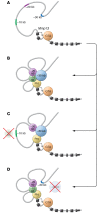The vitamin D receptor: contemporary genomic approaches reveal new basic and translational insights
- PMID: 28240603
- PMCID: PMC5373853
- DOI: 10.1172/JCI88887
The vitamin D receptor: contemporary genomic approaches reveal new basic and translational insights
Abstract
The vitamin D receptor (VDR) is the single known regulatory mediator of hormonal 1,25-dihydroxyvitamin D3 [1,25(OH)2D3] in higher vertebrates. It acts in the nucleus of vitamin D target cells to regulate the expression of genes whose products control diverse, cell type-specific biological functions that include mineral homeostasis. In this Review we describe progress that has been made in defining new cellular sites of action of this receptor, the mechanisms through which this mediator controls the expression of genes, the biology that ensues, and the translational impact of this receptor on human health and disease. We conclude with a brief discussion of what comes next in understanding vitamin D biology and the mechanisms that underlie its actions.
Conflict of interest statement
Figures



References
-
- DeLuca HF, Krisinger J, Darwish H. The vitamin D system: 1990. Kidney Int Suppl. 1990;29:S2–S8. - PubMed
-
- Brumbaugh P, Haussler M. 1α,25-dihydroxycholecalciferol receptors in intestine. I. Association of 1α,25-dihydroxycholecalciferol with intestinal mucosa chromatin. J Biol Chem. 1974;249(4):1251–1257. - PubMed
-
- Brumbaugh PF, Haussler MR. 1α,25-dihydroxycholecalciferol receptors in intestine. II. Temperature-dependent transfer of the hormone to chromatin via a specific cytosol receptor. J Biol Chem. 1974;249(4):1258–1262. - PubMed
Publication types
MeSH terms
Substances
LinkOut - more resources
Full Text Sources
Other Literature Sources

